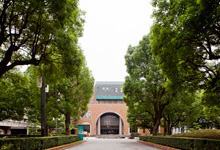What is innovation starting from the campus?
It is clear that we should tackle the big social issue of carbon neutrality, but how should we proceed with the goal of "zero carbon campus"?In a situation where no one is convinced, Chiba University of Commerce talks about "Zero Carbon Campus (a university pioneers in the area)" at Zero Carbon Campus Shop 2, which should be implemented as a local university for regional revitalization that is unique to that area. We invited two speakers, Associate Professor Naoko Hamashima of the University Education Organization and Professor Yasuto Hayashi of Shinshu University, and had a discussion with Professor Tatsuo Katsutoshi of Shinshu University as a facilitator.
What is Zero Carbon Campus? A case study of Chiba University of Commerce
At the beginning of the workshop, Associate Professor Hamashima introduced how the cello carbon campus was realized at Chiba University of Commerce.
At Chiba University of Commerce, following the FIT (fixed purchase system) started in 2012, it started with the construction of a mega solar on the site it owned at the management's discretion.Initially, it generated 60% of the power consumption on campus, but in discussions with Eco-League students and faculty members, it was decided to aim for "energy creation" for the power consumption, and in September 2014, policy informatics at that time. Announced in the name of the director.These activities have generated public interest, and since 2013, the undergraduate program has opened an extension course on environmental policy, providing an opportunity for many people to become aware of university activities and social issues.At the same time, we proceeded with the Net Zero Campus feasibility study and energy saving.This goes well with the founding spirit of the university (cultivation of practical science and commercial morals), and was initially an undergraduate goal, but eventually became a university-wide goal.Currently, the power generated by mega solar is repurchased together with a non-fossil certificate and self-generated by roof-mounted solar power, realizing Japan's first 100% renewable energy university (electric power).
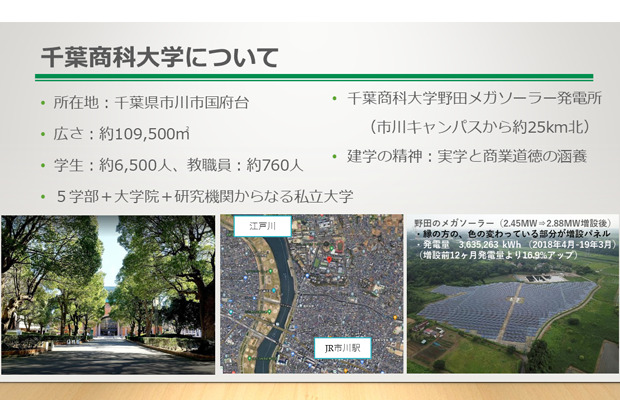
The student group "SONE" was established by expanding into student activities, and they started their own environmental activities.for exampleUnder the initiative and initiative of SONE, the number of vending machines from 38 was reduced to 31, and 19 of them were updated to energy-saving.Discovered the inefficiency of the classroom reservation system from what I noticed in my daily campus life.Improving air-conditioning efficiency by guiding seats in classroom thermography, water sprinkling events, re-energy illumination, etc.At the same time, it is used as a practical educational material, such as by conducting a quantitative effect grasp through questionnaire surveys.
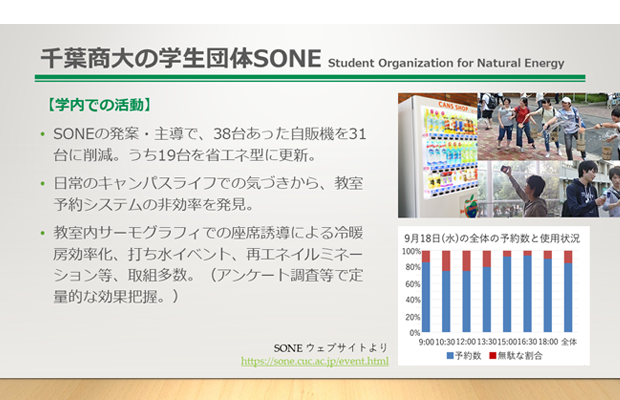
Involvement of local companies-how to encourage participation
In response, Professor Hayashi asked how the university-wide development and penetration into universities and regions were promoted.
Associate Professor Hamashima is always worried, but he listens to the voices of the people involved while having them take the stage at the event and talk to them directly or take questionnaires.
By having the media actively take up the matter, we will get to know it from the outside.He told faculty and staff that since he is conducting lectures on the environment and energy in the liberal arts course, it would be very effective to inform them from an early stage.
Furthermore, at Chiba University of Commerce, accounting, ethical, disaster prevention, and environmental themes are currently being promoted as president's projects.Originally, about 900 companies including local companies have become alliance companies, and as a practical study, students have been trying to connect with companies and communities.Students do not know the area naturally.Although it is becoming online and the connection with the community is decreasing, it is necessary to implement it as active learning even from a part of it.To that end, it is important to "declare" what the university is doing and what it wants to do, says Associate Professor Hamashima.For example, at Hiroshima University, by declaring a zero-carbon campus or decarbonizing the entire region, supporting companies and companies with know-how will be able to teach, and we will set up an office with local governments and companies for specific examination. We are promoting.
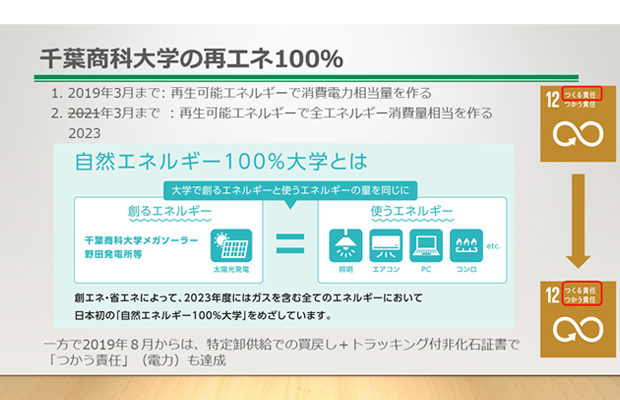
"Fun disaster prevention education" practiced at Chiba University of Commerce is also an activity that started by being close to the needs of the region.For example, by recognizing the risk of flooding in the area where one lives, students will also personalize the task.By creating a ground that faces these regions, the participation of students, regions and companies is encouraged.
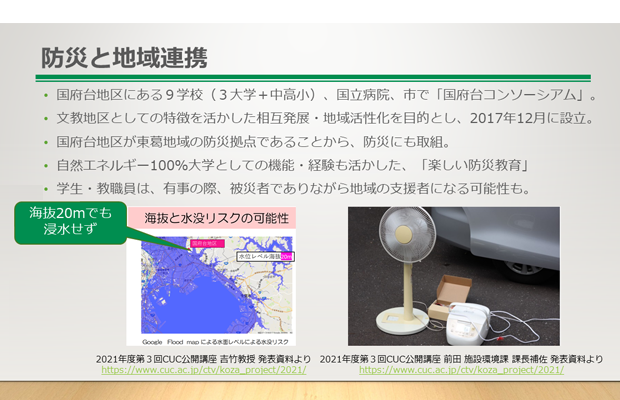
What should the Zero Carbon Campus aim for?
In response, Professor Hayashi introduced efforts to personalize environmental issues through disaster prevention and mitigation in Hakuba.In recent years, disasters have frequently occurred in Nagano Prefecture, such as the disaster of Typhoon Hagiwara (Typhoon No. 19) in the first year of Reiwa and the torrential rain in the Suwa area.Behind the reason for the heavy rain, we cannot help but feel environmental changes and climate change.He said that it is necessary to review what was previously human-centered and focus on the environment, and reflect the values required by society and humankind (social goals such as autonomy and zero carbon) in the appearance of the campus.Just as Mr. Oma's lecture in Part 1 also created a sustainability plan from a logic model, it is necessary to create and execute an action plan for what the university should be.He said that it would be good if there was such an experimental site, academia, to make connections, learn together, make discoveries in it, and grow society as a whole.
To develop human resources who can bring about and execute social change
Professor Hayashi further emphasized the importance of "cultivating human resources who will be the driving force and working together as a team in a circle" in the EGINE program, which is an initiative of Shinshu University, Toyama University, and Kanazawa University. Some students don't even know about local industries such as food, infrastructure, transportation, and tourism. I still don't know what my area or university is doing. Through this program, students are in 3 areas. By seeing, you can re-recognize and know your own area, and from there you can realize an environment where students can get involved in society and learn from each other. Relationship with the area is one step, and by connecting students to the area, I want them to have a sense of engaging with the university and the community. To that end, he said that he would like to promote the creation of a campus and educational environment.
In response to this, Associate Professor Hamashima is related to the importance of university educational activities, and every year, 50 university students graduate from all over the country, and he himself has 20 students behind 400 in the classroom. He says he is giving a lecture because he thinks he is there.Carbon neutral is the way the region and society should be in the future, and even if it is specialized, it covers various fields.This is a “learning opportunity” and an opportunity for major change.Learning at university is directly linked to the very nature of society.Therefore, Associate Professor Hamashima says that by showing the university itself making the right choices, people will grow up and society will change.People who have experienced community activities at the university will become the relevant population in the community in a broad sense even after graduation, so it is more important to create a place for the university, and cooperation with local governments is important for that purpose. ..
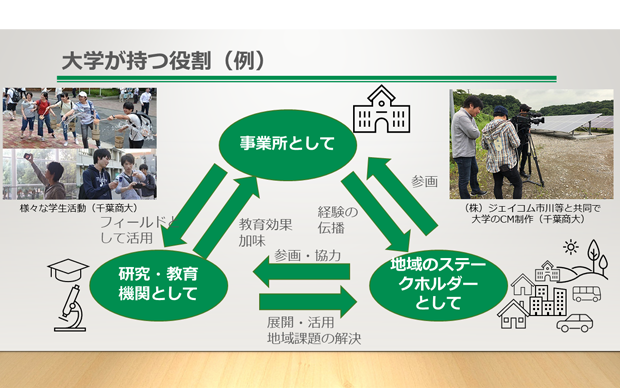
Recognize the space of the campus
Carbon neutral is a good material for widespread discussion in education.In addition to moving on their own, it is also necessary to have the ability to involve companies and propose and approve necessary policies to local governments and the national government.In addition, it is necessary to have a mechanism and a mechanism to continue to connect and support the continuation of actions that are thoughtful for the region, not for people who are far from the region = strangers.How to utilize the education at the university in the real world has changed, and I feel that there is a problem that the society side must change in the future.
From now on, it is necessary to expand the base and increase the number of human resources who are active in the region, including in the environmental field.Among them, the zero-carbon campus is not only "not emitting CO2", but also "people with a mind" who do not emit CO2 and "people who can move around" by creating a "mechanism". One of the goals of the campus is to accumulate that knowledge and experience and return it to the community and society.He concluded that it is also necessary as a "university role" to create a flow in which people come to the university in the wake of the zero-carbon campus, gain something toward carbon neutrality, and return to the region.

